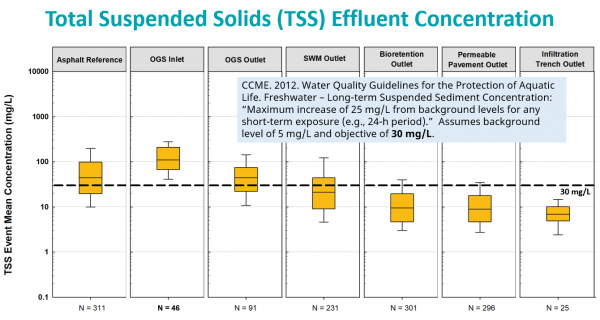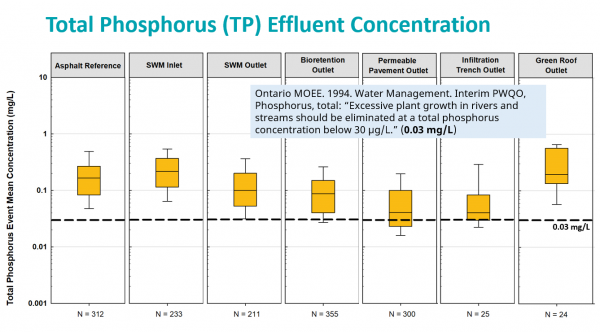Difference between revisions of "Water quality"
Dean Young (talk | contribs) |
Dean Young (talk | contribs) |
||
| Line 9: | Line 9: | ||
==Nutrients== | ==Nutrients== | ||
Plants (including algae) require three macro nutrients to grow: Nitrogen, potassium, and phosphorus. Of these three, phosphorus is the often the "growth-limiting" nutrient. i.e. the local environment may have an abundance of nitrogen and potassium, but algae won't develop unless phosphorus is available too. | Plants (including algae) require three macro nutrients to grow: Nitrogen, potassium, and phosphorus. Of these three, phosphorus is the often the "growth-limiting" nutrient. i.e. the local environment may have an abundance of nitrogen and potassium, but algae won't develop unless phosphorus is available too. | ||
See [[Phosphorus]] page for more on phosphorus. See [[Additives]] page for guidance on filter media additives to enhance retention of phosphorus and other types of pollutants in [[Bioretention]], [[Bioswale]], [[Stormwater Planter]] and [[Stormwater Tree Trench]] facilities. | See [[Phosphorus]] page for more on phosphorus. See [[Additives]] page for guidance on filter media additives to enhance retention of phosphorus and other types of pollutants in [[Bioretention]], [[Bioswale]], [[Stormwater Planter]] and [[Stormwater Tree Trenches| Stormwater Tree Trench]] facilities. | ||
[[File:TP effluent comparison.PNG|thumb|600px|Under the Provincial Water Quality Objectives set out by the Ministry of Environment and Energy in 1994, Total phosphorus effluent leaving a SWM facility should be below a concentration level of 30 μg/L. (0.03 mg/L) (MOEE, 1994)<ref>Ministry of the Environment and Energy. 1994. WATER | [[File:TP effluent comparison.PNG|thumb|600px|Under the Provincial Water Quality Objectives set out by the Ministry of Environment and Energy in 1994, Total phosphorus effluent leaving a SWM facility should be below a concentration level of 30 μg/L. (0.03 mg/L) (MOEE, 1994)<ref>Ministry of the Environment and Energy. 1994. WATER | ||
Revision as of 17:11, 20 March 2023

Overview[edit]
Improvements in the quality of stormwater runoff is one of the primary benefits of low impact development strategies. Although some chemical changes occur inside the practices, much of the pollution reduction of low impact development strategies comes from runoff reduction. i.e. diverting excess water through infiltration or evapotranspiration.
Nutrients[edit]
Plants (including algae) require three macro nutrients to grow: Nitrogen, potassium, and phosphorus. Of these three, phosphorus is the often the "growth-limiting" nutrient. i.e. the local environment may have an abundance of nitrogen and potassium, but algae won't develop unless phosphorus is available too. See Phosphorus page for more on phosphorus. See Additives page for guidance on filter media additives to enhance retention of phosphorus and other types of pollutants in Bioretention, Bioswale, Stormwater Planter and Stormwater Tree Trench facilities.

Practice-specific Water Quality[edit]
You can find practice-specific water quality results from STEP-associated projects over a 25-year period (1997 - 2021). Additional results will be added to this database on an ongoing basis. Click on any of the LID BMPs below to see how the removal efficiencies of these practices compares to the CWQG requirements for Phosphorus and TSS
- Bioretention: Performance
- OGS: Performance
- Permeable pavements: Performance
- Infiltration Trench: Performance
- Rainwater Harvesting: Performance
- Green Roof: Performance
Note: The water quality performance data was collected by the Sustainable Technologies Evaluation Program (STEP). Disclaimer: STEP cannot guarantee the validity of the information found here. While we use reasonable efforts to include accurate and up to date information, we make no guarantees as to the accuracy of the content and assume no liability for an error or omission in the content).
Heavy metals[edit]
The heavy metals noted as particularly harmful to aquatic ecosystems are:
- Chromium(Cr),
- Copper (Cu),
- Lead (Pb), and
- Zinc (Zn)[3]
Laboratory experiments on bioretention media have demonstrated that the organic matter significantly improves retention of lead (Pb), copper (Cu), and zinc (Zn) [4]. This research also found that extended detention of the stormwater in the cell did not improve this water quality benefit.
Cores of media were extracted from five 10 year old bioretention cells in Queensland, Auz and tested for a suite of heavy metals: “Although trace amounts of several heavy metals (most prominently Mn and Zn) were found in most of the basins, all heavy metal levels found in the soil were either below detectable limits, or within acceptable limits based on legislated health-based investigation levels.”[5]
External Links[edit]
- Environment Canada on Phosphorus and Excess Algal Growth
- Lake Simcoe phosphorus reduction strategy
- Canadian LID BMP Database
References[edit]
- ↑ Canadian Council of Ministers of the Environment. 2002. Canadian water quality guidelines for the protection of aquatic life: Total particulate matter. In: Canadian environmental quality guidelines, 1999, Canadian Council of Ministers of the Environment, Winnipeg. https://ccme.ca/en/res/total-particulate-matter-en-canadian-water-quality-guidelines-for-the-protection-of-aquatic-life.pdf
- ↑ Ministry of the Environment and Energy. 1994. WATER MANAGEMENT POLICIES GUIDELINES - PROVINCIAL WATER QUALITY OBJECTIVES OF THE MINISTRY OF ENVIRONMENT AND ENERGY. July, 1994. Reprinted February 1999. ISBN 0-7778-8473-9 rev. https://dr6j45jk9xcmk.cloudfront.net/documents/3016/moeprovincialwaterqualityobjectivesen.pdf
- ↑ Feng W, Hatt BE, McCarthy DT, Fletcher TD, Deletic A. Biofilters for Stormwater Harvesting: Understanding the Treatment Performance of Key Metals That Pose a Risk for Water Use. Environ Sci Technol. 2012;46(9):5100-5108. doi:10.1021/es203396f.
- ↑ Gülbaz S, Kazezyilmaz-Alhan CM, Copty NK. Evaluation of Heavy Metal Removal Capacity of Bioretention Systems. Water Air Soil Pollut. 2015;226(11). doi:10.1007/s11270-015-2640-y.
- ↑ Lucke T, Nichols PWB. The pollution removal and stormwater reduction performance of street-side bioretention basins after ten years in operation. Sci Total Environ. 2015;536:784-792. doi:10.1016/j.scitotenv.2015.07.142.